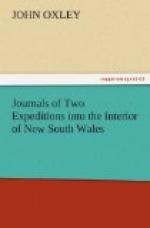Finding that we were entangled among the streams of the Macquarie, I determined on the morrow to proceed by the mountains dividing the north-west and south-west rivers; and if they should lead me considerably westward before their junction, to cross the south-west river, which, from its apparent direction and vicinity to Bathurst, I considered to be the only stream of consequence which we should find between our present station and that place.
Rugged and uneven as the country generally was during this day’s journey, there was considerable intermixture of the good with the barren; many portions consisting of excellent pasture land, and even the rocky hills were divested of the appearance of being so barren as they actually are, by being covered with shrubs and grass intermingled among the box and small gum trees, that find support between the interstices of the stones.
August 28.—At eight o’clock we proceeded on our journey, and pursuing the ridge which separated the two streams, we found that their general direction was from the southward, opening, as we advanced, into fine valleys, rounding gentle rising hills, thinly wooded and covered with grass. The ridge itself was chiefly of slate-rock, intermixed with masses of coarse siliceous granite. We followed the ridge for about six miles, when we descended into the valley through which the south-west rivulet ran, and after travelling about four miles farther, we crossed it when it was running a strong stream. Waiting for the horses at this spot, I took the opportunity of ascending a very lofty conical hill, forming part of the range bounding the north-east side of the valley. From this hill our hopes and expectations were gratified by a view of Bathurst Plains, which I estimated to be distant about twenty-two miles, bearing on the course we were pursuing. A Journal is but ill calculated to be the record of the various hopes and fears, which doubtless in some degree pervaded every mind upon this intelligence: these feelings, whatever they might be, were soon to be realized, and in an absence from our friends and connections of nineteen weeks how much might have occurred in which we were all deeply interested!
After travelling about three miles farther, we stopped for the evening, under expectations that we might possibly reach Bathurst on the morrow.
From the hill whence I saw Bathurst the view in every direction (except north-east, where it was bounded by a range of equal height between me and the river) was very extensive; the country to the southward and south-west was broken into low grassy hills with four intervening valleys. The rivulets derive their main supply from those hills, and from the range upon which we had travelled the greater part of the day: almost every hollow contained a running stream, having its source in springs near the summit of the hills.




